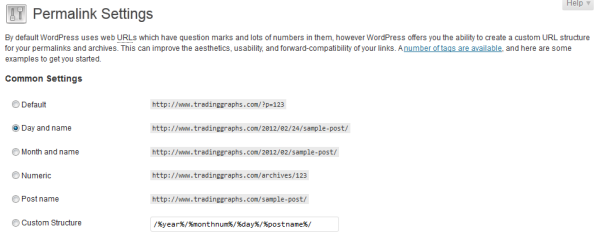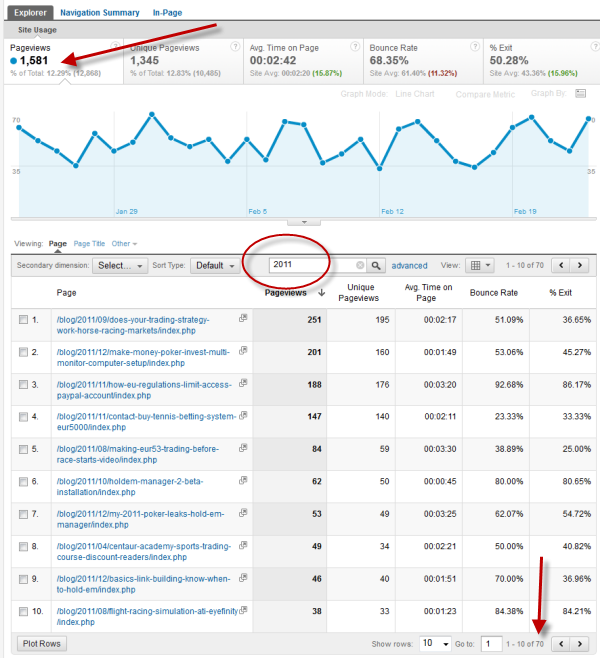Blogging is all about writing great content, right? Google Analytics can determine if your old posts were well-written, but your permalinks need to include the publishing date so that Analytics can sort the posts by date. WordPress permalinks do exactly that by including the year, month and day the posts were published in the blog. Unfortunately some bloggers –count me in – might have selected the permalinks that include the posts’ category for better SEO results, making it much more difficult to find out your blogging performance. In case though you have opted for the standard permalinks’ format, you are in luck!

I began actively blogging again a week ago. Before I did, I thought of how my posts will perform and whether I should spend time on blogging. Nowadays there are 3 blogs I concentrate my efforts on; therefore I figured I must post one article in each blog every day leading to 3 new articles on a daily basis. After all, that is the recommended posting frequency for any aspiring blogger. My goal is not missing a single day for a whole year which will result in about 1,000 posts until February 2013 – if the world exists by then! What would a good performance of those posts be in order for me to be happy?
Usually blogging efficiency translates into traffic, monetization and ultimately money! Forgetting about monetization, which needs extra time and effort, I assumed that by March 2013 ten visitors will read each of those 1,000 articles of mine per month on average. Admittedly some posts will never been read again but although outdated, some others will still be popular because of comments, blog reactions and linking back, eliminating the low performance of others. So, if I don’t post anything during that month or the following ones, my blogs would have gained 10K monthly visitors exclusively due to the specific posts. Obviously this blogging activity will have an impact on the blogs in general, such as increase in readership, rankings and exposure given that nothing will go wrong but I’m willing to forego all that. Yet, my assumption sounded rational and now I had to interpret those figures into cold cash!
Those 10K visitors will hopefully each read one more page before leaving my blog, resulting to 20K pageviews/month. Now let’s say for every 100 pageviews there is one click on an advertisement (1% click-through-ratio is the standard) which corresponds to 200 clicks/month. Charging $0.50 per click (cost-per-click number is a pretty debatable statistic but I believe I am being humble there), blogging every day for a year will eventually earn me at least $100 per month in the future. That does sound promising and I consider blogging a lot more creative than playing poker or investing in the stock market, which I normally do!
After thinking of all that, it was time to look in the past and determine if I was anywhere close to reality. The only blog where I use permalinks that include the publishing data is here at jimmakos.com. When I was installing WordPress after a complete wipeout of the server, I had already disliked the long permalinks of my other blogs. My decision had been made and I chose to go for the typical permalink reading year/month/day and the post’s name. Several months later I’m able to find out the performance of that blog posts with the help of Google Analytics. Bear in mind though that I have copied from my previous Joomla installation only the most popular of the old posts, skewing the final results. Also I had already made the Joomla vs WordPress comparison.
In today’s blog there are 27 posts of 2007, which have been read 837 times during the last 30 days. Blogging performance for 2007 is 31 reads/post. The 30 posts of 2008 did a lot better as they are responsible for 1881 pageviews in the last month, resulting to 62 reads/post. At this point it’s obvious my 10 reads/post assumption was completely wrong.

However, moving on to the most recent 2011 data, Google Analytics shows that my 70 posts were read just 1,581 times for a 22 reads/post figure. The reason is of course that I now include almost all of my blog posts that I published last year, instead of adding up just the most popular ones. Yet, it seems that 20 reads/post would likely be my initial goal in this year’s blogging activity.

Why don’t you compare your own blog posts and see which year your blogging performed better? Perhaps you’ll witness an improvement in your blogging skills, or you need to go back to see what you did better in the past. In any case, measuring your blogging performance with Google Analytics, if you add the date in the WordPress permalinks, is quite easy and gives objective criticism about your blogging and domain business.


